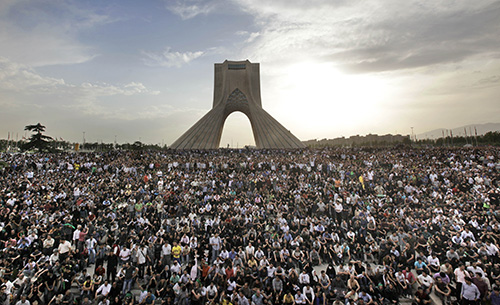This Thursday, CPJ will launch a social media campaign calling for the end of the press crackdown that began on June 12, 2009, the day of Iran’s tumultuous presidential elections.
A lot has changed in five years. The thunderous demand of thousands–“Where is my vote?”–no longer echoes in the streets. The presidential candidates Mir-Hossein Mousavi and Mehdi Karroubi, whose campaigns ultimately helped spark a massive street movement, now languish under house arrest. In place of Mahmoud Ahmadinejad, the anointed victor of the 2009 elections, is Hassan Rouhani, who won a surprise victory last year on a platform of international engagement and reform. With Rouhani’s election, some people have come to feel that 2009 just may be history and that Iran has moved on.
More in this campaign
• Take action
• Timeline
Infographics
• 26 days of arrests
• Jailed journalists
‘Unlock Iran’ Soundbites
• Heightened crackdown
• Citizen journalism
• Spike in arrests
• Uncertain future
But when it comes to press freedom in Iran, too much has remained the same these five years. On election day in 2009, at least nine journalists were behind bars. Twenty-six days later, CPJ announced Iran had officially become the world’s worst jailer of the press with 30 journalists in jail: with further research, the number rose to at least 39, a stunning increase of 333 percent since June 12.
Iran has ranked among the world’s top three worst jailers of the press every year since. In 2013, Iran was holding at least 35 journalists in jail, according to CPJ research. Many more journalists have cycled in and out of prison as part of Iran’s revolving-door policy in which authorities free some detainees on furlough even as they make new arrests. Dozens of others have fled the country, fearing a similar fate. What was once unprecedented has simply become the new normal.
To commemorate the five-year anniversary of the crackdown, CPJ will look back at those three critical weeks in 2009 when Iran’s journalists were imprisoned by the dozens. We will see the costs journalists pay for covering a government bent on crushing the hopes of thousands of protesters. We will see regime officials blame foreign conspiracies for the unrest, attempting to discredit journalists as spies and agents. We will see the first real test of citizen journalism in a time of national crisis, with much of the news in Iran spreading through social media. And we will see how one grainy YouTube video of an Iranian woman named Neda Agha-Soltan bleeding to death from regime bullets can spread like wildfire across the world [Warning: graphic video].
From June 12 through July 7, CPJ’s Middle East and North Africa Twitter account (@cpjmena) will “live tweet” major events in the Iranian crackdown, including anti-press violations, on their five-year anniversaries. We will also be updating the Storify below with the latest tweets (hit Refresh for updated information). Of course, these three weeks will not tell all–or even most–of the story. But they do mark a critical turning point for Iran, one that deserves special scrutiny.
We hope you will join us in sharing your own memories of what happened five years ago. Remember the 2009 crackdown by posting to social media using the hashtags #IranElection and #5YearsAgo. Share your own pictures, videos, and articles from the protests and subsequent crackdown. Or share the soundbites created by Unlock Iran, a campaign run by the Iran Human Rights Documentation Center that calls for awareness of human rights violations against prisoners in Iran.
Below, we have provided some suggested tweets, but we encourage you to write your own as well. Join us in asking Supreme Leader Ayatollah Ali Khamenei why dozens of journalists remain in prison. Ask President Hassan Rouhani why the crackdown that began under his predecessor in 2009 continues. Ask why the Association of Iranian Journalists, banned in 2009, has not been allowed to reconvene despite Rouhani’s promises. Ask why international journalists are often barred from entering the country. Ask why imprisoned journalists are consistently mistreated by their jailers. Ask why the judiciary has not enforced Article 134 of the new Islamic penal code, which reduces the combined sentences of detainees, including journalists.
Five years later, the time for the 2009 crackdown to end is long past.
Take action:
Share the following tweets between June 12 and July 7, or write your own.
- The number of jailed journalists skyrocketed #5YearsAgo and has never gone down since #IranElection http://t.co/XUuZdsFMMx Tweet
- President @HassanRouhani, will you end the crackdown on the press that began #5YearsAgo? #IranElection http://t.co/0g0wrz8gau Tweet
- Ayatollah @khamenei_ir, it is time to end the 2009 #IranElection crackdown against journalists. #5YearsAgo http://t.co/XUuZdsFMMx Tweet
- .@HassanRouhani will you honor your pledge to unban the Association of Iranian Journalists? #5YearsAgo #IranElection http://cpj.org/x/59af Tweet
- Ayatollah @khamenei_ir, why don’t you stop the mistreatment of journalists in jail? #5YearsAgo #IranElection http://cpj.org/x/5a28 Tweet
- Minister @JZarif, how can Iran conduct “constructive engagement” while 2009 #IranElection crackdown continues to this day? http://t.co/XUuZdsFMMx Tweet
- Ayatollah @khamenei_ir, why do prisoners languish in jail while Article 134 goes unenforced? #5YearsAgo #IranElection bit.ly/1xERabI Tweet
Timeline of the 2009 crackdown
[View the story “Time to end a five-year crackdown in Iran” on Storify]
UPDATE: This blog has been updated to include the graphics created by Unlock Iran.
